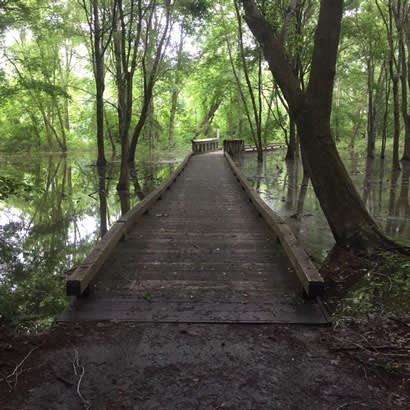
Mark Battista, a naturalist with the Chesterfield County Parks and Recreation Department in Virginia, tops off his water bottle before moving out into the thick summer heat. Battista has been asked to explore and catalog unique ecosystems and document any rare, threatened or endangered species existing on a tract of land the county is considering purchasing. Such evaluations are part of the park design process the agency uses to make decisions about future public facility development within the region.
Undeveloped land typically has a much lower tax value when compared to improved property. Conventional economic development practices seek to maximize the value of raw land through its conversion to housing, retail or some other profitable use. This change in use results in increased income for real estate professionals, construction companies and material suppliers, while also generating tax revenue for the local government. Property development is usually supported by elected officials and many in the business community due to those anticipated economic benefits.
Such a narrowly focused definition of value discounts the worth of open space and woodlands within a community. Parks and conservation areas directly contribute to the health of municipalities through improvements in air and water quality, ecological diversity, aesthetics and increased recreation opportunities. Yet, there remains a tendency to look at parks, conservation areas and wildlands as desirable amenities, rather than as critical public infrastructure.
This mindset contradicts countless studies conducted since the mid-1970s, highlighting the importance of humans spending time outdoors. Assigning a monetary value to the improved emotional and physical well-being of people who spend time in nature is difficult, but such contributions must be considered in resource allocation decisions. While private foundations and other non- governmental organizations play a role in land conservation, local governments, specifically parks and recreation agencies, are best positioned to acquire and maintain these critical ecological repositories.
Parks as Avenues to Promote Environmental Stewardship
Within the United States, thousands of park and recreation and other agencies manage more than 3 billion acres of parks, refuges, forests, open spaces, preserves and other lands intended to provide outdoor recreation opportunities, support ecological diversity and preserve wildlife habitats. Local agencies’ connections to communities, relationships with regional leaders and opportunities to introduce young people to the outdoors through nature programming provide avenues to promote environmental stewardship.
Access to nature has a significant impact on urban youth. Many of the behavioral issues our educators struggle with may be directly related to the increasing separation between children and the outdoors. Unstructured play in a natural environment improves self-sufficiency, problem- solving ability, and aids in the development of attention spans. Convincing parents that the cure for all that torments their children lies in the fields and woods beyond the edge of the city may be difficult, but the contributions exploring nature makes to the adaptability and well-being of children cannot be denied.
A community’s devotion to environmental conservation defines the region. Park and recreation agencies shape that culture of place through the development of the next generation of conservation-minded leaders. In the absence of such leadership, conservation efforts are often cast aside in favor of more immediate needs. Funding for the preservation of unique ecosystems is difficult to obtain in locales struggling to meet public safety and community welfare needs. While safety and security may indeed be indispensable for the normal day-to-day functioning of society, it is important to remember that experiences in parks and other outdoor settings shape the future.
The Importance of Public Outreach and Education
Park and recreation professionals must take the lead in ensuring that future generations will have opportunities for outdoor adventure and wilderness experiences. This is possible only through the complete integration of land conservation into the planning function of local governments. Assessments of undeveloped properties, such as those conducted by Battista, provide valuable information to the planning and construction divisions within agencies. Analysis of in-the-field findings helps balance providing public access to unique ecosystems with preserving the integrity of those important natural areas.
Conservation is a fundamental pillar of most park and recreation agencies, but other sectors of government often focus on the more tangible elements of economic development and service provision. Public outreach and education should be part of any conservation plan. Elected officials must know that their constituents are passionate about conserving open space. Enlisting the support of state and federal agencies, recognizing elected officials’ support of conservation and publicizing the public’s efforts to better the environment all play a role in maintaining support for conservation within communities.
Opportunities for land conservation often result from donations of property or available grant funding. While these are both valuable mechanisms for increasing the amount of green space within an area, departments can be proactive in their conservation efforts. Collaborating with citizens, birding clubs and other organizations makes agencies aware of important natural resources or unique habitats on private property. That information can be cataloged to develop an acquisition priorities list to guide future land purchases by local government. Identification of those ecological gems within a region allows agencies to campaign for their purchase, should they become available.
Conservation is an established tenant within the park and recreation field. Working to fully integrate those values into the broader governmental framework will require citizen support, engaged community leaders and impassioned advocacy by agency staff. Elevating wild space preservation to an equal footing with police and fire protection is possible, but agencies must actively promote conservation efforts within their communities. Hopefully, elected officials will realize the value of letting their citizens “go wild.”
Robert Smet is the Assistant Director for Chesterfield County Parks and Recreation.

